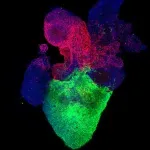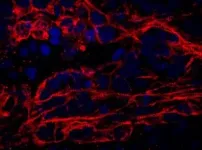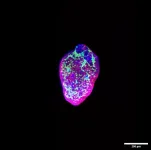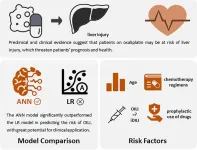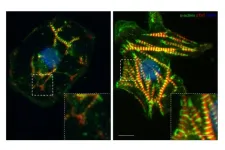How nearly identical RNA helicases drive “mRNA export” via distinct protein complex pathways
Scientists reveal that a single amino acid difference leads to the formation of functionally unique protein complexes.
2024-02-08
(Press-News.org)
Genetic expression, often leading to protein synthesis, requires a complex coordination of molecular machinery across several stages. A vital step in protein-coding gene expression is messenger RNA (mRNA) export, which involves shuttling mature mRNAs from the cell’s nucleus to the cytoplasm.
The mRNA export process relies on mRNA–protein complex formation, with the evolutionary conserved ATP-bound TREX complex playing a pivotal role. Among its components, the RNA helicase UAP56 is perhaps the most important one during its assembly. Not only does UAP56 participates during mRNA splicing in some transcripts, but it also recruits necessary proteins for export upon ATP binding. It is noteworthy that the ATP-unbound form of the TREX complex is termed “apo-TREX,” while the ATP-bound form is “ATP-TREX.”
Interestingly, mammals share a paralogue of UAP56, an almost identical gene known as URH49. Scientists demonstrated that URH49 also forms an mRNA–protein complex, called “apo-AREX,” which significantly differs in composition from apo-TREX. However, upon binding to ATP, apo-AREX transforms into a complex nearly identical to ATP-TREX. They are so similar that they are both called APT-TREX regardless of whether the precursor was apo-AREX or apo-TREX. Despite studies showing that UAP56 and URH49 complexes export different subsets of mRNA, little is known about the structural and functional differences between the apo-complexes formed by these distinct RNA helicases.
In a recent study published in Nature Communications on 15 January 2024, a research team from Japan, led by Professor Seiji Masuda from Kindai University in Japan, aimed to address these knowledge gaps. Their paper was co-authored by Dr. Ken-ichi Fujita of Fujita Health University and the National Cancer Center Research Institute, Dr. Masaki Kojima of Tokyo University of Pharmacy and Life Sciences, Dr. Bunzo Mikami of Kyoto University, and Dr. Akila Mayeda of Fujita Health University et al.
First, the researchers conducted immunoprecipitation experiments in genetically modified cells expressing immunotagged UAP56 and URH49 to identify the components of the apo-complexes. They identified several factors that are part of apo-AREX, including RUVBL1, RUVBL2, ILF2, and ILF3, which are not present in ATP-TREX complexes.
Subsequently, the team investigated the functional significance of these factors. Through knockdown experiments using short interfering RNAs, they found that depleting any of the factors resulted in mature mRNA accumulation in the cell nucleus. Additionally, there was an increase in the expression of UAP56 targets as a compensatory mechanism. These findings suggest the identified factors play a crucial role in the apo-AREX complex, ultimately regulating URH49-specific mRNA transport.
Next, the researchers focused on the structural differences between apo-AREX and apo-TREX complexes. “We hypothesized that differences in a specific regions between UAP56 and URH49 are important to form their distinct apo-complexes,” explains Prof. Masuda. “To identify the regions, we created plasmids expressing various mutants of UAP56 and URH49, swapping different parts.” On top of this, they conducted several additional experiments involving characterizing the crystal structure of URH49 using X-ray diffraction and studying the differences between the ATP-bound and ADP-bound TREX complexes.
Interestingly, the team discovered that a change in a single amino acid between UAP56 and URH49 is enough to determine the formation of either apo-TREX or apo-AREX complexes. By examining the Sub2 gene in yeast, the ancestor gene of UAP56, the researchers concluded that the apo-structure of UAP56 was evolutionarily conserved, whereas that of URH49 emerged during evolution as a point mutation that ultimately resulted in new functions.
Overall, this study has shed some light on both the similarities and differences between two important complexes formed by RNA helicases. This understanding is vital for comprehending their distinct roles during mRNA processing and export. “Components of the TREX and AREX complexes appear to be overexpressed in a variety of cancer cells. Maintaining adequate expression of these components could be important to keep cells healthy, and their aberrant expression may also be a cause of cancer,” comments Prof. Masuda.
Hopefully, continued exploration of these protein complexes will help scientists not only understand the evolution of eukaryotes, but also lead to new diagnostic and therapeutic strategies for challenging diseases.
END
ELSE PRESS RELEASES FROM THIS DATE:
2024-02-08
An advanced human heart organoid system can be used to model embryonic heart development under pregestational diabetes-like conditions, researchers report February 8 in the journal Stem Cell Reports. The organoids recapitulate hallmarks of pregestational diabetes-induced congenital heart disease found in mice and humans. The findings also showed that endoplasmic reticulum (ER) stress and lipid imbalance are critical factors contributing to these disorders, which could be ameliorated with exposure to omega-3s.
“The new stem cell-based organoid technology employed will enable physiologically relevant studies in humans, allowing us to bypass animal models and obtain more information ...
2024-02-08
PITTSBURGH, Feb. 8, 2024 — In a new study of nasal decongestant purchasing patterns, researchers at the University of Pittsburgh School of Medicine found that phenylephrine remained the most popular choice year after year, despite decades of concerns over a lack of evidence supporting its effectiveness.
Published today in JAMA, the research letter points to a coming wave of supplychain disturbances if the Food and Drug Administration (FDA) moves to pull oral phenylephrine from the shelves, as recommended by an FDA advisory panel in 2023 that found the medication ineffective.
The researchers ...
2024-02-08
About The Study: Despite a lack of clinical efficacy evidence, phenylephrine was the most common oral decongestant in the U.S. from 2012-2021, with hundreds of millions of units purchased by retail pharmacies annually, and sales remained stable during this time. In contrast to pseudoephedrine, which is often formulated as a stand-alone product, most phenylephrine products were co-formulated with antihistamines or antitussives, which are likely to provide some symptom relief for cough and cold symptoms.
Authors: Timothy S. Anderson, M.D., M.A.S., of the University of Pittsburgh, is the corresponding author.
To access the embargoed study: Visit our For The Media website at ...
2024-02-08
About The Study: The results of this study demonstrated that home environment features, particularly lighting, may influence home activity metrics in older adults with visual impairment. Further prospective studies would be needed to confirm if home modifications can improve at-home activity.
Authors: Pradeep Y. Ramulu, M.D., M.H.S., Ph.D., of the Johns Hopkins University School of Medicine in Baltimore, is the corresponding author.
To access the embargoed study: Visit our For The Media website at this link https://media.jamanetwork.com/
(doi:10.1001/jamaophthalmol.2023.6436)
Editor’s Note: Please see the article for additional ...
2024-02-08
BOSTON – The vast majority of liver transplant centers in the United States use language on their websites that can be considered stigmatizing through their use of words like “alcoholism,” “alcoholic” and “alcohol abuse,’ potentially hindering care and the willingness of patients to seek treatment, a study by Massachusetts General Hospital (MGH) has found.
In highlighting a significant gap between that online usage and the practice recommendations of medical ...
2024-02-08
One of the country’s best-known science museums, San Francisco’s Exploratorium, is located less than three miles north of Gladstone Institutes—a proximity that has resulted in creative, high-science collaborations like the permanent exhibit featured in the latest issue of Stem Cell Reports.
Among the museum’s most popular exhibits, “Give Heart Cells A Beat” opens a rare window into the microscopic world of the beating human heart, using technology and materials made ...
2024-02-08
Since 2004, several clinical studies have reported that patients with OXA frequently experienced adverse effects of liver injury (LI), typically characterized by hepatic sinusoidal injury, splenomegaly, decreased platelet count and noncirrhotic portal hypertension, which can progress to nodular regenerative hyperplasia with long-term treatment. LI also decreased hepatic functional reserve and aggravated the postoperative course of colorectal cancer patients after hepatectomy, and may affect intraoperative bleeding, postoperative morbidity, and overall survival. LI can ...
2024-02-08
Natural scientist and author Robert Rothman takes readers on a reptillian tour of the Galápagos Islands in his new book, A Paradise for Reptiles: Lizards, Snakes, and Giant Tortoises of the Galápagos Islands Vol. 1: Tortoises, Geckos, and Snakes, published by RIT Press.
For more than 30 years, Rothman has led hundreds of Rochester Institute of Technology students on tours to the Galápagos Islands to observe the wildlife and landscape that inspired Charles Darwin’s theory of evolution by natural selection. Rothman’s A Paradise for Reptiles, an homage to the 19th century scientist, is an accessibly written guide for anyone interested in Darwin, the Galápagos, ...
2024-02-08
Language use in social media can be a useful tool for social scientists, because it reflects living conditions in areas the posts originate from.
“There is a correlation between social inequalities and language patterns in social media,” says Associate Professor Lucas M. Bietti at the Norwegian University of Science and Technology (NTNU’s) Department of Psychology.
Researchers studied 30 million X/Twitter posts from the United States. They compared the language used in the tweets to the living conditions in the counties from which the ...
2024-02-08
For some leukemia patients, the only potential chemotherapy option is a drug that also carries a high risk of heart failure. This means that some patients who recover from their cancer will end up dying of heart disease brought on by the cure.
In a new study, researchers from the University of Illinois Chicago and other universities have identified mechanisms that cause the drug, ponatinib, to harm the heart. They also identified a promising treatment that could reverse this process. The paper, with senior author Sang Ging Ong, assistant professor of pharmacology and medicine at UIC, is published in Circulation Research. The study is part of a growing field called cardio-oncology ...
LAST 30 PRESS RELEASES:
[Press-News.org] How nearly identical RNA helicases drive “mRNA export” via distinct protein complex pathways
Scientists reveal that a single amino acid difference leads to the formation of functionally unique protein complexes.

